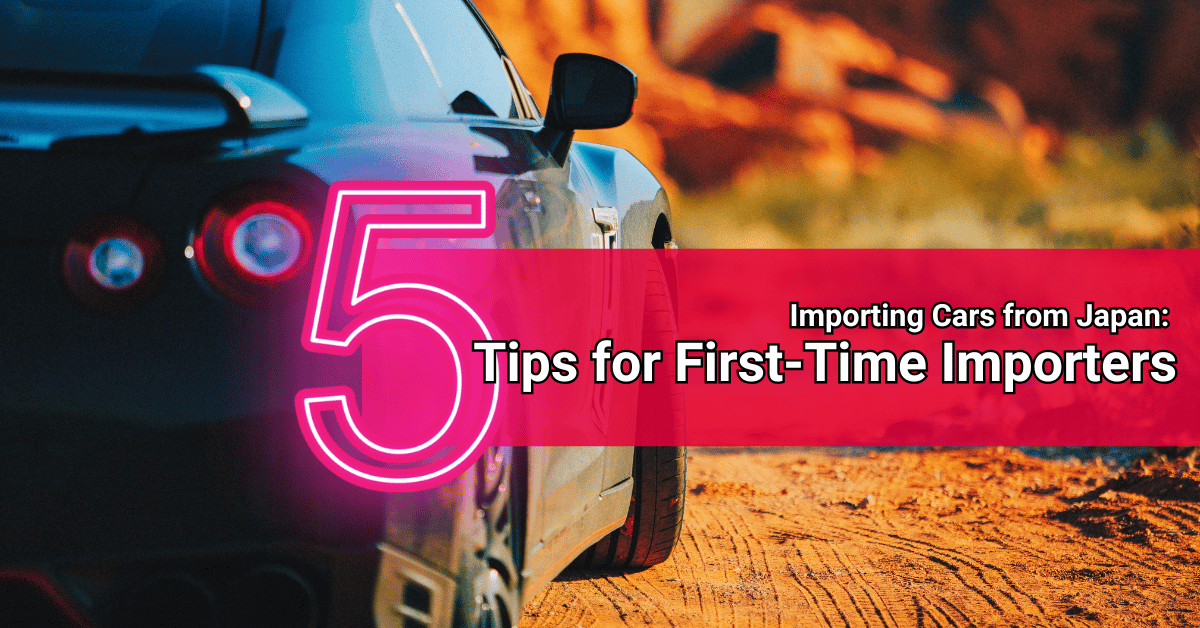Importing a used car from Japan can be an exciting endeavor, giving you access to an impressive range of vehicles known for their quality and reliability. However, a few essential steps must be considered to make the process seamless and successful. Previously, we shared 4 Tips for first-time car importers. This time, we’re bringing you even more! Here are the top 5 pro tips for importing used cars from Japan for the first time:
1. Understand Import Regulations and Compliance
Before you start browsing for your dream car, it’s crucial to familiarize yourself with your country’s import regulations. Each country has specific laws governing vehicle imports, including emissions standards, safety requirements, and vehicle age restrictions. Failure to comply with these regulations can result in delays, fines, or even the rejection of your imported vehicle.
Key Points:
- Research Import Regulations: Study the import laws of your country thoroughly to understand what is permissible and what is not.
- Customs Duties and Taxes: Be aware of the customs duties, taxes, and fees applicable to imported vehicles. These costs can significantly impact your budget. Some countries also require inspection fees to make sure that the vehicle complies with the local emissions standards or safety regulations. So always make sure you know about it and include that in the other fees you may be required to pay.
Check out this article for an extensive list of import regulations by country here.
2. Assess Vehicle Condition and Inspection
The condition of the vehicle you intend to import is paramount. Conducting a thorough inspection before purchase ensures you’re making a well-informed decision and helps avoid unexpected expenses post-purchase.
Key Points:
- Pre-Purchase Inspection: Obtain a detailed inspection report from a trusted source to assess the car’s mechanical condition, mileage, and any previous accidents or repairs. If not, the repairs or sourcing of your parts after you retrieve the vehicle could be detrimental to your budget.
- Auction Grades: Understand the Japanese auction grading system, which indicates the vehicle’s overall condition. Higher grades typically denote better quality but it can also be quite costly to purchase.
In 2024, Carpaydiem Co., Ltd. in collaboration with Toyota Tsusho Corporation launched the TTA Auto Auction service. Here you can also check for vehicle auction sheets and auction grades if you have a Carused.jp account. To learn how to read auction grades, visit our page below.
3. Navigate Shipping and Logistics
Once you’ve selected your vehicle, the next step is arranging its transportation from Japan to your home country. Understanding the different shipping methods and associated logistics will help you choose the most suitable option.
Key Points:
- Shipping Methods: Compare Roll-on/Roll-off (RoRo) versus container shipping options based on cost, security, and convenience. In a majority of cases, RoRo is the way to go but there could also be restrictions of shipping methods available depending on the port and vessel.
- Shipping Time and Costs: Factor in the shipping duration and costs when planning your import timeline and budget. Shipping schedules change dramatically depending on factors such as climate, political, and geographical hurdles.
4. Manage Documentation and Paperwork
Proper documentation is essential for a hassle-free import process. Ensuring you have all necessary paperwork in order and translated as needed will facilitate smooth customs clearance upon arrival.
Key Points:
- Required Documents: Gather documents such as the bill of lading, export certificate, inspection certificate, and any other pertinent paperwork. Check with your local ports, insurance companies, and government to see which sets of paperwork you need because some countries require more while other countries require just the basic paperwork for pickup.
- Translation Services: If documents are in Japanese, arrange for accurate translations to avoid misunderstandings or delays. Many exporting companies in Japan will provide translations of the required documents but also ask for them just in case.
5. Choose a Reputable Exporter
Working with a reliable exporter is crucial to ensure transparency, quality, and a smooth transaction process. Researching and selecting a reputable partner will help safeguard your investment and peace of mind. Many exporters in Japan have decades of experience in exporting used cars from Japan to all over the world so don’t be afraid to ask for advice on what to do if you are not sure.
Key Points:
- Research and Reviews: Look for well-established used car exporters from Japan, with positive reviews and a track record of customer satisfaction. Here at Carused.jp, we are proud to have over 15 years of experience exporting Japanese used cars and as a subsidiary of Toyota Tsusho Corporation, we have access to over 150,000 cars from a wide range of auction houses to help you look for your dream car at the lowest possible prices.
- Communication: Maintain clear and open communication with your chosen exporter throughout the import process to address any questions or concerns promptly. Carused.jp offers services and consultations in English, French, Swahili, Portuguese, and even Chinese! So that everything goes smoothly to ease your anxiety of getting your first Japanese imported car.
By following these essential guidelines, first-time importers can navigate the complexities of importing cars from Japan with confidence and success. With careful planning, thorough research, and attention to detail, importing your dream Japanese car can become a rewarding experience, offering you access to quality vehicles that meet your specific preferences and requirements.
If you are still unsure, feel free to reach out to trusted exporting companies like Carused.jp. We are happy to provide you with the most support to ensure you get your dream car as easily as possible!



